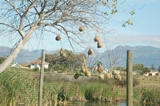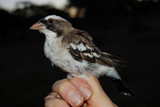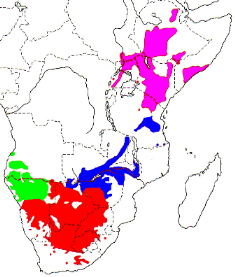Weaver species
Choose different species from drop-down list and press 'Go' button. See Full species list.White-browed Sparrow-Weaver Plocepasser mahali
IUCN: Least concern Discovery: 038Categories: Plocepasser, long tube, cooperative, acacias, gum, Gymnogene, nectar, Nest use,
News items about species
Discovery
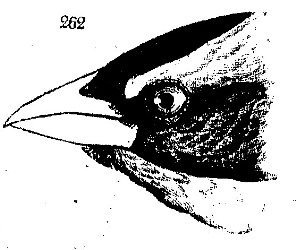
figure from Swainson 1837 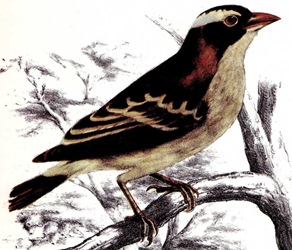
figure from Smith 1841 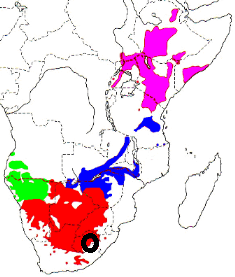
distribution, type locality circled IntroductionThe White-browed Sparrow-weaver was collected and formally described by Andrew Smith, a Scottish surgeon, explorer, ethnologist and zoologist. Smith organised an expedition to the interior and he travelled to near the Botswana border in 1834-35, collecting many new birds, reptiles, mammals and other taxa along the way.Smith described the White-browed Sparrow-weaver from between the Orange River and the Tropic (Smith 1836) and later he described the locality as 'upon a tree on one of the tributary streams of the great northern branch of the Orange River' (Smith 1841). Smith crossed the Vaal, Modder, Black Modder and the Riet rivers (Smith 1836: 15) on his journey between Thaba Nchu and Philippolis on 4-17 December 1834. From his diary, it is clear that Smith moved east from Thaba Nchu until he reached the Modder River (Oschadleus 2007). He stayed here a few days collecting specimens, including the White-browed Sparrow-weaver, then moved south-east to Philippolis (Kirby 1939). Macdonald (1957) correctly restricted the type-locality to the Modder River near Bloemfontein. Clancey (1957, 1959) incorrectly changed this to the confluence of the Modder and Riet rivers, because he thought that Smith did not cross the Modder River near Bloemfontein. Clancey based his supposition on the map in Kirby (1940) where the upper reaches of the Modder River are not shown, but he did not read the diary. The first illustration of a White-browed Sparrow-weaver was published by Swainson 1837, based on a specimen Smith sent to England. The first colour illustration was published by Andrew Smith in 1841 in his well known work, Illustrations of the Zoology of South Africa, and the White-browed Sparrow-weaver was painted by George Henry Ford. Scientific citationPlocepasser Mahali Smith 1836; Rep. Exped. Centr. Africa, p.51; 'country between the Orange River and the Tropic' = Modder River, Thabanchu, South Africa.Meaning of namesmahali - no explanation given by Smith, not a Latin name, probably based on an African name.Skead (1967) noted that it was probably named after the Tswana word mogale or Sotho word Mohale which mean a brave or fierce person, suggesting that the bird may be named for its angry scolding. First English nameThe Mahali Philagrus (Reichenbach 1863).Alternate namesBlack-billed Mahali Weaverbird, Black-billed Sparrow Weaver, Kismayu Sparrow-Weaver, Stripe-breasted Sparrow Weaver, White-browed Weaver Bird, White-crowned Weaver-Bird.CollectorAndrew Smith.Date collected6 Dec 1834.Locality collectedModder River, near Thaba Nchu, Free State, South Africa.Type specimensThere are at least 3 syntype specimens in different museums: BMNH 1845.7.6.132, ANSP 14256 and ANSP 14257. |
The above is based on Weaver Wednesday 2, a weekly series about the discovery of each weaver species.
This species text first appeared as
Weaver Wednesday [155] - Discovery [38]: White-browed Sparrow-weaver on 2015-06-02
1. Basic biology
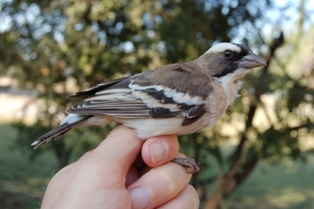
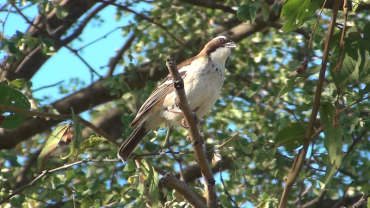
Identification.
The White-browed Sparrow-Weaver is a large brown and white weaver that is fairly common. It has a conspicuous broad white stripe from above the eye backwards, and 2 prominent white wing-bars and wing edgings. In flight, a large white patch on the rump and uppertail-coverts is visible.
Distribution.
The White-browed Sparrow-Weaver the most widespread of the sparrow-weavers, occurring in southern and eastern Africa. It has four subspecies:
The White-browed Sparrow-Weaver appears to have increased its range and abundance in many areas (read more here and Kruger). For example, in the Eastern Cape it was first seen on Rookwood farm in the 1980s, and since 2000 has several colonies (see sparrow-weaver colonies on Rookwood here). This species has probably increased in number of nests at Barberspan (see here). The species seems to be increasing in Kenya, e.g. it was described as a new-comer to Ngulia in the past 2 years (VM 1977) and is increasing in Nairobi. Habitat. The White-browed Sparrow-Weaver inhabits mopane and acacia savanna, with <600 mm annual rainfall. It is also found in riverine fringes and gardens. Food.
The White-browed Sparrow-Weaver feeds on insects and seeds. Insects include termites, weevils, tenebrionid beetles, ants, caterpillars and small moths. Seeds of grasses and cereals are important in winter. It takes bread and other scraps at camp sites.
Breeding. The White-browed Sparrow-Weaver is a colonial, cooperative breeder, living in groups of 2-11 birds. There is a single breeding female in each group, that is replaced by another group member in time. There is a dominant, breeding male that is eventually replaced from outside the group. Helpers related to the breeding pair help defend the territory and feed the young; unrelated helpers only help in group defence of the territory. The average colony size is 16 nests, but may be up to 20 nests in a single tree. The nest is an elongated retort ball, with a domed roof. It is built only from dry grasses 15-60cm long. One occupied nest contained 983 pieces of grass. About 60% of roosting nests are converted to breeding nests by closing one of the 2 entrances, and then lining with feathers. The nest is placed in trees, 2-8 m above the ground. Mopane and Acacia trees are often favoured. Most nests are placed on the side of the tree away from the prevailing wind. Nest construction takes 10-18 days; and is by both members of the pair and helpers may contribute. Nest-building activity is throughout the year. Its nest sometimes has a longer entrance, as shown right. Birds like the Ashy Tit Parus griseus, Black-checked Waxbill Estrilda erythronotos and Red-headed Finch Amadina erythrocephala may use their nests for roosting. |
The above is based on Weaver Wednesday, a weekly series about weaver species.
This species text first appeared as
Weaver Wednesday [2]: White-browed Sparrow-Weaver on 2012-06-27
2. Breeding facts
| Pair bond Monogamous, co-operative breeding system with helpers Breeding season throughout year in Kenya and South Africa depending on local conditions in areas of irregular rainfall; mostly Mar-May in E Africa, but Jul-Aug on Laikipia Plateau (Kenya); Nov-Dec in Angola, peak Dec-Mar in Zambia, Oct-Feb in Malawi, May-Jun in Botswana Nest site placed 2-8 m above ground in tree such as mopane, Sclerocarya caffra, or acacia (at least six species recorded) Nest building Nests built throughout year, but especially after rain; construction taking 10-18 days Colony size n/a Clutch size 2-3 Egg colour salmon-pink or creamy white, either evenly speckled with red, brown and grey, or markings forming band at thick end Egg size average 24.9 x 16.4 mm (South Africa) Incubation incubation by female alone, period 14-16 days Chicks and nestling period young fed by female alone for first 2-3 days, then also by male and helpers, chicks in nests with helpers grow faster; nestling period 17-18 days in Zambia, 21-23 days in South Africa, 25 days in captivity |
Breeding information based on Handbook of the Birds of the World, Vol. 15.
3. Photos of Weaver Nests
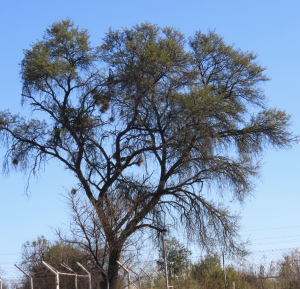 Vm 31112 | 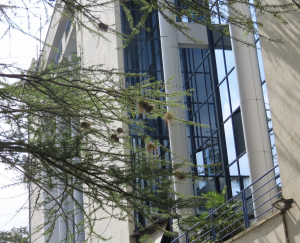 Vm 31110 | 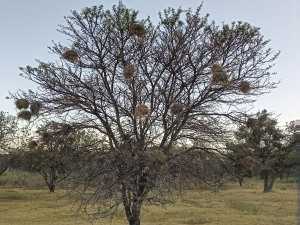 Vm 31092 | 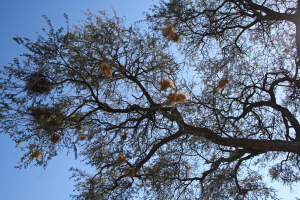 Vm 31085 | 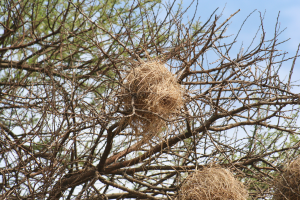 Vm 31084 | 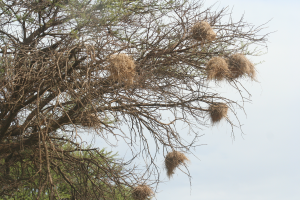 Vm 31083 |
Thumb-nails of most recent PHOWN records - click on one to see its full record
See all PHOWN records for this species here.
PHOWN (Photos of Weaver Nests) provides valuable info on breeding distribution and colony sizes of weavers.
You can contribute by registering and submitting photos at Virtual Museum webpage.
4. Breeding distribution
Google map showing distribution (For species with small ranges you need to zoom in at the correct area to see the range):
yellow blob - range of weaver species; read more about this here.
![]() - PHOWN records with photos
- PHOWN records with photos
![]() - PHOWN records with no photos (Nest Record Cards, other records)
- PHOWN records with no photos (Nest Record Cards, other records)
![]() - Birdpix records
- Birdpix records
![]() - comments on out of range records, or interesting records
- comments on out of range records, or interesting records
![]() - type locality
- type locality
CLICK on the marker on the map to see individual record details.
5. Range changes
Read more in Biodiversity Observations.
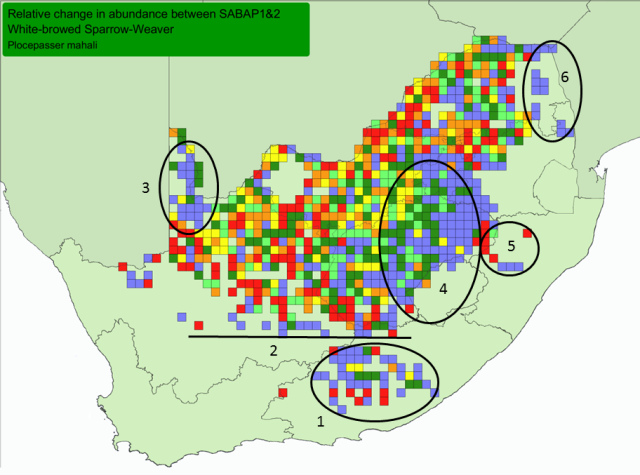
Red, orange and yellow = cells with very large, large, and small relative decreases Blue, dark green and light green = cells with very large, large and small relative increases. Cells = quarter-degree grid cells; Only cells with at least 4 checklists in both SABAP1&2 shown. All cells had this species recorded in SABAP1 or in SABAP2 or in both (more about interpretation at Biodiversity Observations 7.62: 1-13). Range changes in SA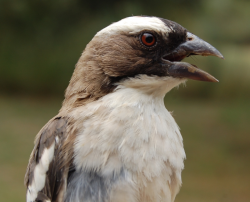
figure from Birdpix
1. Population increase in the Eastern Cape
2. Historic southern limit
3. Population increase in Kgalagadi Transfrontier Park
4. Population increase in the Free State
5. Population increase in KwaZulu-Natal
6. Population increase in the Lowveld and Kruger National Park
Range changes elsewhereKenya: increase in numbers in Nairobi (Oschadleus 2014d). | |||||||||||||||||||||||||||||||||||
The above is based on Weaver Wednesday 3, a weekly series about range changes in South African weaver species.
This species text first appeared as
Weaver Wednesday 3 [239] - Range changes [2]: White-browed Sparrow-Weaver on 2017-01-11








